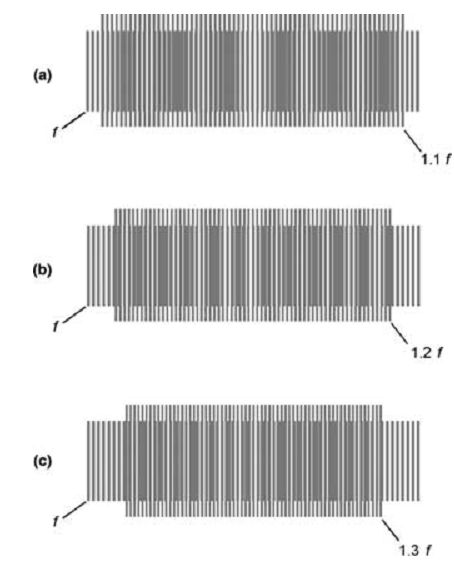Heterodyning:
No matter what is the mode, and despite of the medium, waves mix to generate other waves. Whenever this occurs with sound, the effect is termed as beating; whenever it occurs with radio signals, it is termed as heterodyning, or mixing. Two sound waves which are close to each other in pitch will beat to build a new wave at a much lower frequency and the other wave at a higher frequency. When you have access to a music synthesizer or a laboratory signal generator, you can do an experiment to elaborate this. Whenever two notes in the treble clef are played loudly at similar time, you will hear a low-frequency hum. This is the lower-pitched of the two beat notes. The higher-pitched note is harder to observe. The figure shows illustrations of wave beating in which the low-frequency notes are visually apparent. In portion a, the waves, shown by sets of vertical lines, vary in frequency by 10 % (f and 1.1f); in portion b, by 20% (f and 1.2f), and in part c, by 30% (f and 1.3f).

Figure: Two waves can beat to build a new wave at the difference frequency. (a) The two waves vary in frequency by 10%. (b) By 20%. (c) By 30%.
Beat and heterodyne waves forever take place at a frequencies equivalent to the sum and difference among the frequencies of the waves which generate them. When you play two notes altogether, one at 1,000 Hz and the other at 1,100 Hz, a beat note emerges at 100 Hz. Whenever notes at 1,000 Hz & 1,200 Hz are combined, a 200-Hz beat wave is the outcome. When you adjust a music synthesizer to play notes at 1,000 Hz & 1,300 Hz, there is a 300-Hz beat note. When you hold one note stable and continuously differ the frequency of the other, the beat notes increase and fall in pitch. When you can secure the use of a fine synthesizer, you must try this experiment. The beat notes will appear to come from a direction you cannot specify. It is a bizarre sensation, not to be missed by the truly dedicated audiophile.
Radio-frequency heterodyning was introduced by engineers in the early 1900s. Under certain situations, two wireless signals join to generate a new signal at the difference frequency. It is simple to design a circuit to generate this effect. However, the phenomenon, not forever preferred, is hard to prevent.
Provided two waves containing various frequencies f and g (in hertz), where g > f, they beat or heterodyne altogether to generate new waves at frequencies x & y (in hertz) as follows:
x = g - f
y = g + f
Such formulas also exert for frequencies in kilohertz, megahertz, gigahertz, and terahertz-given, obviously, which you stick with similar units through-out any given computation.